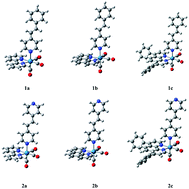The mechanism of photoisomerization of stilbene-like ligands coordinated to rhenium polypyridine or α-diimine carbonyls is deciphered in the light of recent theoretical results obtained at various levels of theory, density functional theory (DFT, time-dependent DFT) and state-of-the-art ab initio methods, complete active space self-consistent field (CASSCF) and multi-state CAS perturbation theory 2nd Order (MS-CASPT2). On the basis of the electronic absorption spectra and potential energy profiles (PEF) associated to the low-lying singlet and triplet intra-ligand (IL) and metal-to-ligand-charge-transfer (MLCT) excited states, coupled by spin–orbit interactions and calculated for the series [Re(CO)3(N,N)(L)]+ with N,N = bpy, phen and ph2phen (bpy = 2,2′-bipyridine; phen = 1,10-phenanthroline; ph2phen = 4,7-diphenyl-1,10-phenanthroline) and L = stpy or bpe (stpy = 4-styrylpyridine; bpe = 1,2-bis(4-pyridylethylene) it is shown that the dynamics of the isomerization process are controlled by several features: (i) the occurrence of a 1ILL/1MLCTNN conical intersection in the vicinity of the 1MLCTNN absorption domain (ii) the kinetics of 1MLCTNN/3MLCTNN intersystem crossings; (iii) the kinetics of 3MLCTNN/3ILL internal conversion. The branching ratio between the two main isomerization pathways, namely along the 1ILL PEF via1MLCTNN/1ILL internal conversion at the conical intersection or along the 3ILL PEF after 3MLCTNN/3ILL charge transfer is largely influenced by the nature of the N,N antenna and L isomerizable ligands.
